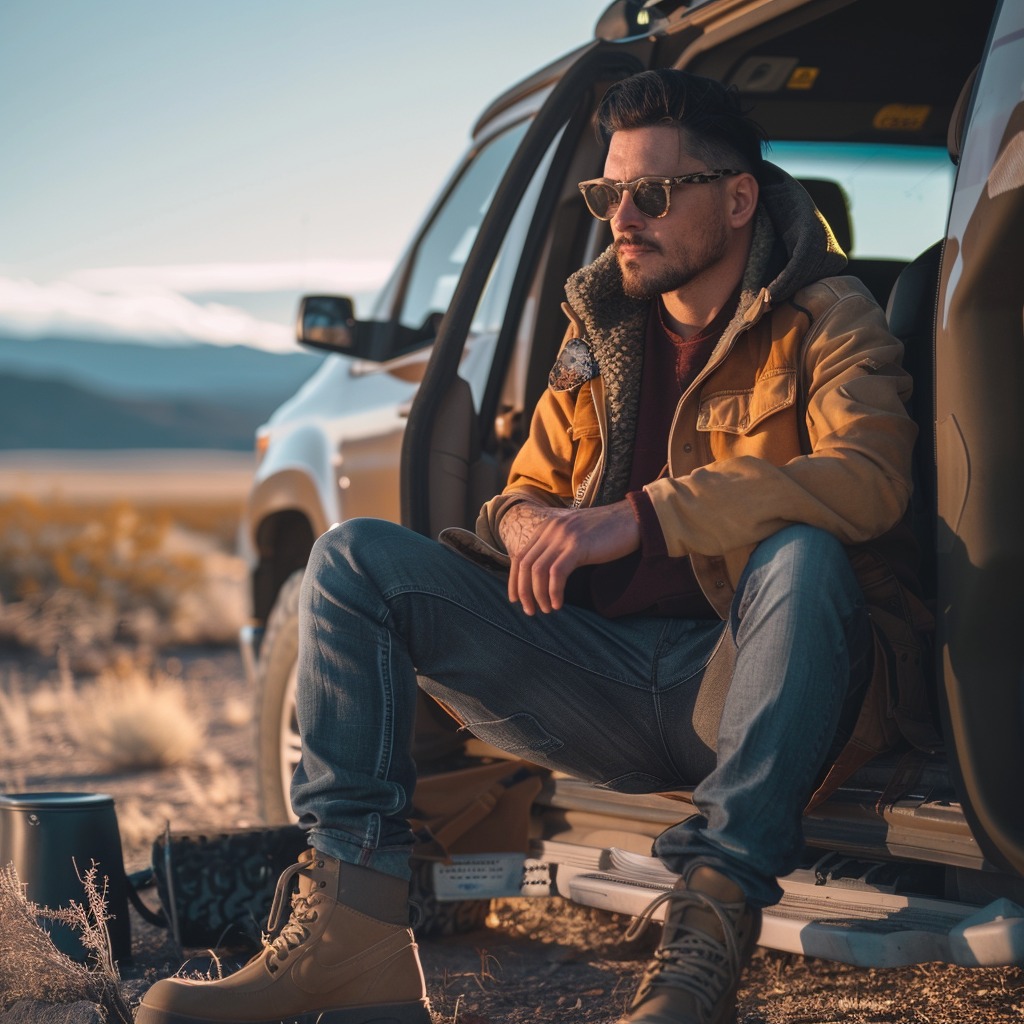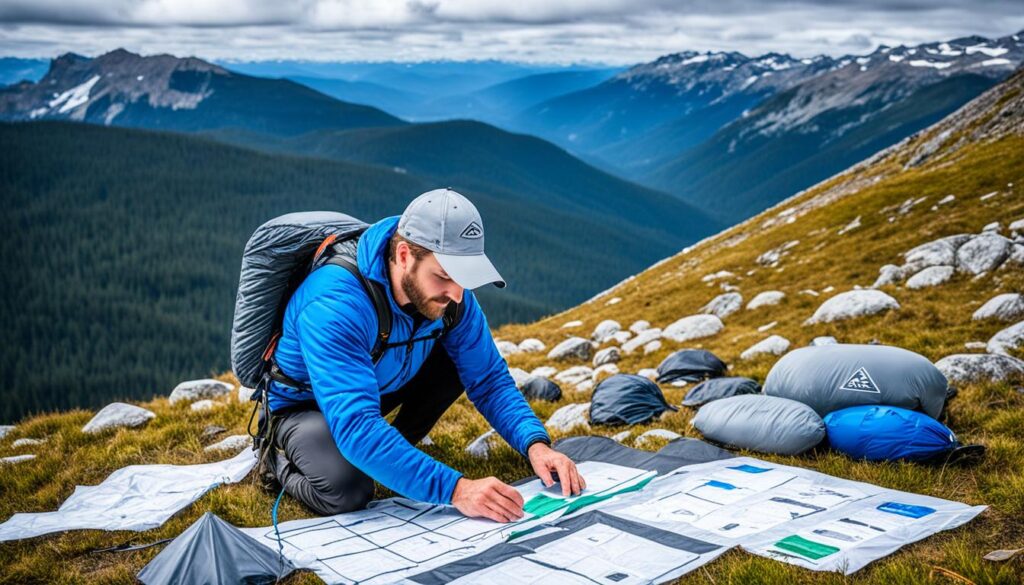Ultralight tents and shelters need a lot of care. Using a tent footprint helps protect the tent’s floor from abrasion, wear, and damage. This extra sheet guards the tent from small tears and adds a layer of insulation from the cold ground. For ultralight backpackers and thru-hikers, choosing the correct tent footprint material is important. It helps in keeping the backpack lighter while maintaining the tent’s protection.
Key Takeaways
- Ultralight tents and shelters require extra care and protection to ensure their longevity.
- A tent footprint or ground sheet can shield the delicate tent floor from abrasion, wear, and damage.
- Tent footprints can also provide insulation between the ground and the tent.
- Choosing the right tent footprint material is crucial for ultralight backpackers and thru-hikers.
- Selecting a lightweight and compact tent footprint can help keep pack weight down.
What is a Tent Footprint and Why Use One?
A tent footprint is like a ground sheet for your ultralight tent. It goes underneath to protect it. If you’re moving around in your tent, the friction with the ground can cause damage over time. By using a footprint, you avoid this wear and tear.
Protection Against Abrasion and Wear
The tent floor of your ultralight shelter is quite light and can tear easily. This happens when it keeps touching the ground. A tent footprint acts like a barrier. It stops the abrasion and wear that damage your tent’s floor.
Insulation from the Ground
Moreover, the extra layer under your tent adds a bit of insulating effect. This is good in the cold. It keeps ultralight backpackers and minimalist campers a little warmer.
Choosing an Ultralight Tent Footprint Material
Most ultralight tents don’t have a footprint included. So, backpackers and thru-hikers make their own from materials like Tyvek and Polycro. These materials are great for keeping the ground beneath your tent safe. They are important for ultralight tent footprint options, lightweight ground cloths, and minimalist camping gear.
Tyvek: Lightweight, Puncture-Resistant, and Waterproof
Tyvek is what builders use for house insulation. Ultralight hiking equipment fans love it because it’s tough and small for your bag. It’s not as light as Polycro, but setting it up is easier. Tyvek keeps you dry and is great for waterproof footprint solutions with backpacking accessories and tent floor savers.
Polycro: Extremely Light and Compact but Less Durable
Polycro, used for insulating windows, is super light. It folds very small but be gentle because it’s not as strong as Tyvek. For easy to carry portable campsite essentials, Polycro is a top choice. It’s exactly what minimalist camping gear needs.
Ultralight Tent Footprint Options: Pros and Cons Compared
Choosing between Tyvek and Polycro for an ultralight tent footprint depends on your needs. Tyvek is tough and ready to use, and it’s from the world of home insulation. This makes it a bit easier for setting up for those on big hikes. The flip side is, it’s a tad heavier than Polycro and doesn’t handle wind as well.
Tyvek: Easier to Set Up but Heavier
Setting up a tent with Tyvek is simple and quick, which is a big plus. It stands tough in windy and rough spots, thanks to its durability. But, it’s not the lightest choice out there, giving Polycro an edge for the ultra weight watchers.
Polycro: Ultralight but Requires Extra Care
Polycro, a super thin film for windows, is the choice for really light setups. It weighs next to nothing and packs super small. However, it tears easier and moves around more than Tyvek, needing careful handling.
In the end, your choice between Tyvek and Polycro comes down to your hiking style. If you want something tough and easy to use, Tyvek is for you. For those who are all about the weight, Polycro might be the better fit.
DIY Ground Sheets: Cost-Effective Alternatives
Ultralight backpackers can choose to make their own ground sheets. This can be a cheaper option than buying pre-cut Tyvek or Polycro tent footprints. Tyvek and Polycro are often sold in rolls or kits. This lets hikers cut the material to the size they need. Painter’s drop cloths or thin plastic sheeting are budget alternatives. They offer good protection but at a lower cost. Making your own requires measuring and cutting accurately. Yet, it’s a smart way to spend less without compromising on quality.
Tyvek and Polycro Rolls and Kits
Ultralight tent footprint options like Tyvek and Polycro come in rolls or kits. This makes customizing easy for your tent or shelter. It’s a cost-effective way of getting a lightweight ground cloth. Cutting your own material means you get the size just right. This maximizes the benefits without adding weight to your compact backpacking essentials.
Painter’s Drop Cloths and Plastic Sheeting
For a DIY approach, painter’s drop cloths or thin plastic sheeting are good choices. They work well as waterproof footprint solutions and are cost-effective. Although these ground cloths need more attention when setting up, they help ultralight backpackers save money and weight. You get all the necessary protection for your tent floor saver without overspending.
Tips for Using Tent Footprints Effectively
Many ultralight backpackers and thru-hikers use a lightweight tent footprint. It’s key to get the right ultralight tent footprint options, lightweight ground cloths, and durable tent protection. Here are a few tips for making the most of them.
Proper Sizing and Setup
When picking ultralight hiking equipment, choose a footprint slightly smaller than your tent floor. This stops waterproof footprint solutions from holding water in the rain. Also, lay out the footprint carefully to make a flat area for your minimalist camping gear and backpacking accessories.
Separate Storage for Dirty Footprints
Keep your tent floor saver in a dry bag or stuff sack after using it. This stops dirt and moisture from getting on your compact backpacking essentials. It helps keep your portable campsite essentials neat.
Drying and Maintenance After Use
It’s important to let the tent footprint dry completely in the sun. This stops mold and mildew, making your waterproof footprint solutions last longer. They’ll keep giving you durable tent protection during many trips.
Weighing the Need for a Footprint
Using an ultralight tent footprint is popular with ultralight and backpacking fans. But, it’s crucial to think about if you really need one. Some skilled backpackers say a footprint isn’t needed. They argue it just adds extra weight. They believe it’s enough to pick a good tent site and clear it of sharp things. Others think a footprint is vital. It helps protect the floor of ultralight tents from being damaged.
The choice to use a footprint varies. It depends on what’s important to you. It also depends on your tent or shelter and the kind of outdoor situations you’ll be in. If keeping your stuff lightweight and easy to carry is your top concern, you might skip the footprint. But, for those who care a lot about their tent lasting long and staying dry, a footprint could be smart to get.
Conclusion
Choosing the right ultralight tent footprint matters to people who love minimal packing. It’s key for backpackers and thru-hikers to protect their tents’ fragile parts. This goal is to keep their pack weight as light as possible.
Tyvek and Polycro are common materials for custom groundsheets. They differ in durability, weight, and how easy they are to use. Knowing the benefits and downsides of each helps ultralight fans keep their tent floors in great shape over many trips.
Picking a ready-made tent footprint or making your own from minimalist gear is crucial. The focus is on keeping your tent floor safe yet fitting everything into your ultralight hiking gear. With proper protection for your tent floor, your essentials will stay clean and ready to use outdoors.
Looking into different waterproof footprint solutions and using them well is essential. This step helps ultralight backpackers get more out of their camping gear. It ensures their gear lasts through many camping adventures.
Recommended
- BEST BED TENT TO BLOCK OUT LIGHT FOR SLEEP
- BED TENT FOR TRAVEL: SLEEP COZY ON-THE-GO
- INDOOR BED TENT FOR CAMPING COMFORT & FUN

Meet Noah, the soul behind “Best Inflatable Tent” and a true wanderer at heart. Living the van life, Noah has turned his passion for exploring the great outdoors into a lifestyle, earning his living through organizing group travels that bring people closer to nature. With years of firsthand experience in the wild, Noah’s expertise in selecting and utilizing inflatable tents is unparalleled. Through this blog, he shares his profound knowledge and practical tips to help fellow adventurers find their perfect outdoor shelters. Noah’s commitment to delivering genuine, tested insights has made him a trusted authority in the camping community. Join him on this journey to discover the best inflatable tents that make the great outdoors feel like home.
